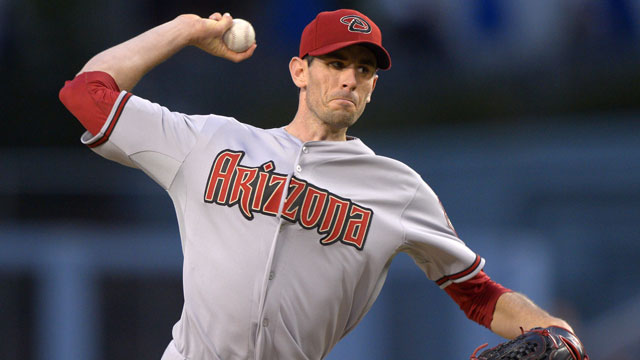David Price and Jeff Samardzija are bound to generate more attention than any other starters on the trade market this summer for good reason. They’re pitching well, their teams have little hope of contending and they’re controllable beyond 2014.
But the problem with Price and Samardzija is that it’ll cost multiple top prospects to acquire them. And good luck getting any kind of salary relief from the Tampa Bay Rays or Chicago Cubs unless you’re prepared to surrender even more prospects.
So some teams will look beyond the top of the pitching trade market for arms who can contribute in 2014. For example, Toronto Blue Jays general manager Alex Anthopoulos might be interested in ways of upgrading his pitching staff without surrendering top young arms such as Aaron Sanchez. While finding pitching is always a challenge, clubs that dig enough will find a pitcher capable of providing quality innings who’s both available and affordable: Brandon McCarthy.
There’s a bit of a catch, as McCarthy has an NL-worst 1-10 record and a 5.38 ERA. But three scouts and executives on opposing teams told Sportsnet that McCarthy intrigues them nonetheless.
Yes, there are plenty of reasons to take a long look at the Arizona Diamondbacks right-hander even if his back-of-the-baseball-card numbers are downright ugly. Let’s start with the strikeout to walk ratio of 80 to 18 in 97 innings. McCarthy can command the zone.
His fastball velocity is up to 93 mph and he’s generating more swings and misses than usual. The stuff is there.
Then there’s the ground ball rate, which currently sits at 56 percent. Pitchers who keep the ball on the ground are well-equipped to limit extra base hits, which is why one executive suggested McCarthy’s numbers would improve with better defence behind him.
While home runs (15) and hits (117) have plagued McCarthy this year, there’s reason to expect those rates to return to normal as the season progresses. He has allowed a batting average on balls in play of .339 and more than one-fifth of fly balls allowed have become home runs. Both are exceptionally poor ratios. Thankfully for McCarthy, they aren’t particularly predictive of future results. There’s plenty of reason to expect him to provide respectable innings going forward, even if he’s not about to start a playoff series for anyone.
But even considering the likelihood of positive regression for a 30-year-old with a long history of mid-rotation production, there’s a consensus that the Diamondbacks would not be able to ask for much in return given McCarthy’s poor record. In fact, industry speculation suggests Arizona would have to take on a considerable portion of his $9 million salary to facilitate a deal.
McCarthy’s far from the only potential buy-low starter out there. And make no mistake — Samardzija and Price are better pitchers worth pursuing if the fit exists. But general managers would do well to consider under-the-radar options in the next five weeks. After all, as fans of Ubaldo Jimenez and Ricky Nolasco could tell you, investing in the so-called best options available doesn’t always work out.
Plus, it’s been done before. The 2009 Cardinals added John Smoltz, who had posted an 8.33 ERA with good peripheral numbers for the Boston Red Sox before rebounding in St. Louis as the Cardinals won the division title. Two years later, the Detroit Tigers wanted Doug Fister despite his 3-12 record and pedestrian strikeout numbers. They were rewarded when he went 8-1 with a 1.79 ERA down the stretch for the eventual American League Central winners.
Landing a top starter affordably will be difficult at a time that many contending teams are looking to bolster their rotations, so as asking prices soar on Price and Samardzija teams will also want to consider alternatives. And if the Blue Jays want to buy low in search of the next Smoltz or Fister, they’d do well to take a long look at McCarthy.









